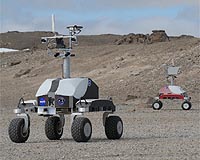 |
Washington (AFP) June 16, 2009 NASA embarks on a landmark mission of lunar exploration this week with the launch of probes to scout for water sources and landing sites, in a bid to lead humanity back on the first visit to the moon since 1972. The US space agency, with its eye on sending astronauts to Earth's natural satellite by 2020, is on course to blast off the dual LRO and LCROSS missions on Thursday atop an Atlas V rocket -- a day behind schedule to accommodate the delayed shuttle Endeavour. It is the first step on the long haul journey to launch explorations further into our solar system, to the planet Mars and beyond. "The robotic mission will give us information we need to make informed decisions about any future human presence on the moon," program manager Todd May told reporters on Monday. The Lunar Crater Observation and Sensing Satellite (LCROSS) in particular looks set to be one of NASA's most spectacular bids at discovery for years. With the objective of seeking out water ice on the moon -- a critical component for any planning for manned lunar colonies -- the probe will hurl itself into one of the permanently shadowed lunar craters, on the dark side of the moon that never sees sunshine. At impact, the kamikaze explorer will be traveling at approximately 1.55 miles per second (2.5 kilometers per second) -- some 5,580 mph (9,000 km/h). It's impact will be a two-fold effort. First the craft's second stage rocket, after having detached from the probe just under 10 hours earlier, will slam into the moon and be followed just minutes later by the probe so the scientific instruments can burrow as deep as possible. In total, NASA said, the two impacts will excavate some 500 metric tons of lunar material. The 79-million-dollar effort will culminate in searching the crater for signs of a possible long-frozen water source and examining the unseen world's mineral makeup. The Lunar Rerconnaissance Orbiter, or LRO, hopes to push forward the space effort's knowledge base through a one-year stay at an orbit of about 31 miles (50 kilometers) -- the closest any spacecraft has continually orbited the moon. LRO's 500-million-dollar mission is designed to provide NASA with maps of unprecedented accuracy, which will be crucial for scoping out possible landing sites. Both missions, May said, will help NASA model the nuances of lunar lighting and temperature range, and provide future moon travelers with information on the cosmic radiation the moon is exposed to due to its lack of atmosphere. Finally, the probes' four-day, 238,000 mile (384,000 km) return to the moon forty years after humans first set foot on its surface is expected to illuminate our closest extra-terrestrial neighbor like never before. Both LRO and LCROSS missions, May said, promise to teach the long distance explorers "the process that formed the earth, the moon and the solar system." The agency hopes the probes will answer a full plate of fundamental questions of cosmic history. "Earth is subject to erosion processes from air and water," noted May. "The moon itself doesn't have this process... LRO will send back pictures daily on things we have barely seen before." Meanwhile, the shuttle Endeavour was on track for launch Wednesday from Kenney Space Center at Cape Canaveral, Florida on a mission to take six Americans and a Canadian to the International Space Station, NASA officials said. The Endeavour's launch, now scheduled for 540 am Wednesday (0940 GMT), was delayed Saturday because of a hydrogen leak in an external fuel tank. Share This Article With Planet Earth
Related Links Mars News and Information at MarsDaily.com Lunar Dreams and more
 NASA Ames Robots Explore Lava Flow In Simulated Lunar Mission
NASA Ames Robots Explore Lava Flow In Simulated Lunar MissionMoffett Field CA (SPX) Jun 15, 2009 NASA robots soon will begin exploring the dusty, rocky terrain of a barren desert on Earth much like the moon. Scientists and engineers will study the images and information the robots gather to help plan where humans should venture next. To simulate robots scouting on the lunar surface before a human space crew arrives, the "K10 Red" and "K10 Black" robots developed at NASA Ames Research ... read more |
|
| The content herein, unless otherwise known to be public domain, are Copyright 1995-2009 - SpaceDaily. AFP and UPI Wire Stories are copyright Agence France-Presse and United Press International. ESA Portal Reports are copyright European Space Agency. All NASA sourced material is public domain. Additional copyrights may apply in whole or part to other bona fide parties. Advertising does not imply endorsement,agreement or approval of any opinions, statements or information provided by SpaceDaily on any Web page published or hosted by SpaceDaily. Privacy Statement |